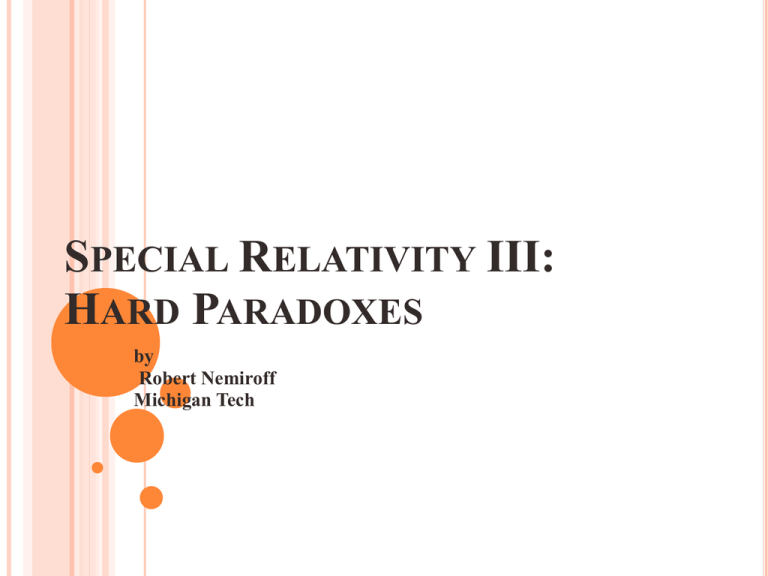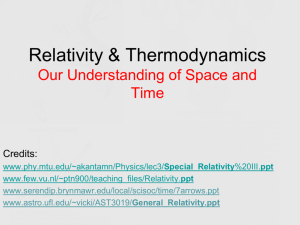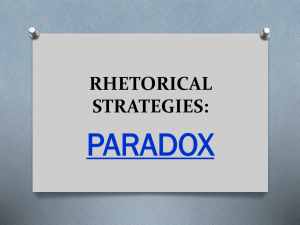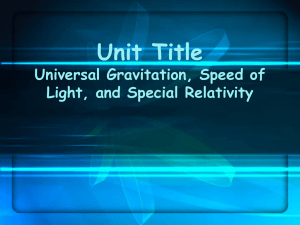SPECIAL RELATIVITY III
advertisement

SPECIAL RELATIVITY III: HARD PARADOXES by Robert Nemiroff Michigan Tech Physics X: About This Course • Pronounced "Fiziks Ecks" • Reviews the coolest concepts in physics • Being taught for credit at Michigan Tech o o o o Michigan Tech course PH4999 Aimed at upper level physics majors Light on math, heavy on concepts Anyone anywhere is welcome • No textbook required o Wikipedia, web links, and lectures only SPECIAL RELATIVITY: TWIRLING POLE PARADOX You hold a really long pole. You hold one end firmly and twirl the pole so that the free end goes around in a big circle. Can the free end go faster than c? 1. 2. 3. No. Every physical object must travel less than c. Yes, for a long enough pole twirled fast enough, the free end must go faster than c. Where's the barn? I heard this paradox had a barn. SPECIAL RELATIVITY: TWIRLING POLE PARADOX 1. No. Every physical object must travel less than c. The pole end is real and cannot move at v > c. The problem is that such a pole cannot be perfectly rigid. Information cannot move ALONG the pole at v > c so that the end of the pole cannot know that the inner parts of the pole are twirling. A perfectly rigid pole would break. A very elastic pole would twist into a spiral pattern with the free end constrained to move at v < c. SPECIAL RELATIVITY: SUPERLUMINAL SCISSORS PARADOX Can the vertex point of a closing scissors move faster than the speed of light? 1. 2. 3. Yes, this is just like the blinking paradox. No, the scissors is real, and nothing real can travel FTL. The most important thing is to walk -- not run -- when carrying scissors. SPECIAL RELATIVITY: SUPERLUMINAL SCISSORS PARADOX It's actually quite complicated! For a standard scissors starting from rest, the information that the scissors is closing can only move down the blade at v < c, and so the vertex must also have v < c. HOWEVER, once a scissor blade is moving along its entire length, the vertex point can move at v > c. Picture two lines on the page that are nearly -- but not exactly -- parallel, where one is moving down the page. The intersection point can move across the page at an arbitrary speed. The same can be true for scissors! Curvature of the blades also can provide v > c vertex examples, some of which are really strange. SPECIAL RELATIVITY: SUPERLUMINAL SCISSORS PARADOX • If one arm is tilted and just translates without rotating past a stationary arm, this is NOT a rigidity problem. • An object pushed by the vertex must move at v<c. • No information can be communicated at v > c by the vertex. SPECIAL RELATIVITY: SUPERLUMINAL SCISSORS PARADOX For cases when the vertex does move at v > c: Observational points of view: • Pointy tip of scissors: o o • vertex will appear to move toward the handle this is the opposite of the way it really moves Handle of scissors: o o vertex will appear to move towards the pointy tip will indeed appear to move FTL SPECIAL RELATIVITY: SUPERLUMINAL SCISSORS PARADOX Observational points of view (when v>c): • Midpoint(s) of shears o o vertex will always appear to move away from the observer toward both the handle and the tip. vertex will appear to reach the tip before it reaches the handle (for closing scissors). SPECIAL RELATIVITY: ILLUMINATION FRONT PARADOX Illuminate a nearly vertical board with a flash light: A completely vertical board would be illuminated all at once. A slightly titled board would have one side illuminated first. A "wave" of illumination would climb the board. Seen from the flashlight, this wave could move with v > c. Observers at either end of the board would disagree on even the direction the wave of illumination was moving. No observer can use this wave to communicate faster than light SPECIAL RELATIVITY: LADDER PARADOX Also called the "Barn and the Pole" paradox. You hold a long ladder and run toward a short garage. If you run fast, can you trap the ladder in the garage? or ? SPECIAL RELATIVITY: PARADOXES LADDER PARADOX Yes, you can trap the ladder in the gararge. The information that the front end of the ladder has hit the back end of the garage can only move along the ladder at v < c. As this information moves, the back end of the ladder can pass into the garage and the garage door can be closed. We then get to see if the ladder is stronger than the door. SPECIAL RELATIVITY: TWIN PARADOX One twin stays home. One twin rockets away and then comes back. Special relativity implies time dilation for moving objects, but each moved only as seen by the other. Which twin is older? 1. 2. 3. The twin who stayed home is older. The twin who rocketed away and came back is older. Symmetry demands they are the same age. SPECIAL RELATIVITY: TWIN PARADOX 2. The twin who rocketed away & came back is younger. The symmetry is broken because the leaving twin had to accelerate to come back, whereas the staying twin experienced no acceleration. Is this a way to travel into the future? Yes. Time travel this way is permissible. There is no way to use the twin paradox to travel BACK in time. Play with an online twin paradox applet. Play the Nova shockwave game.








